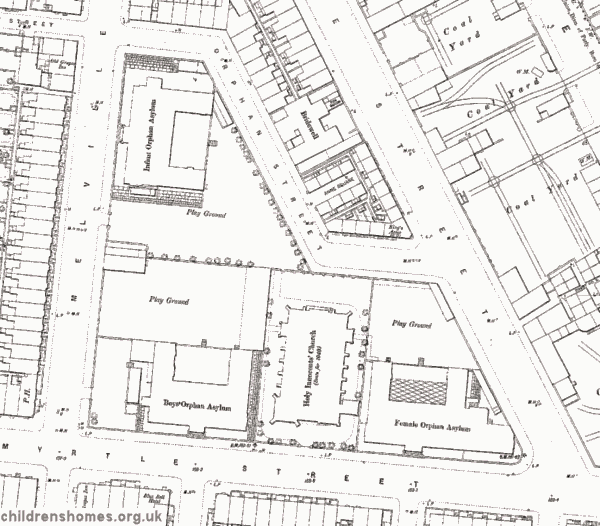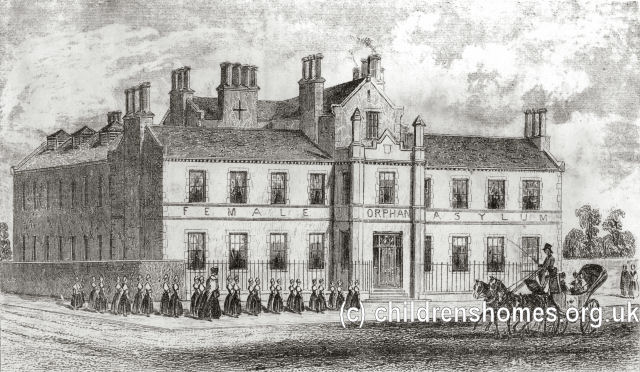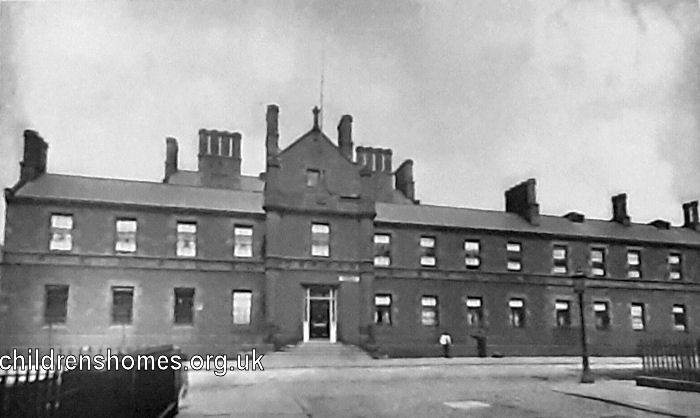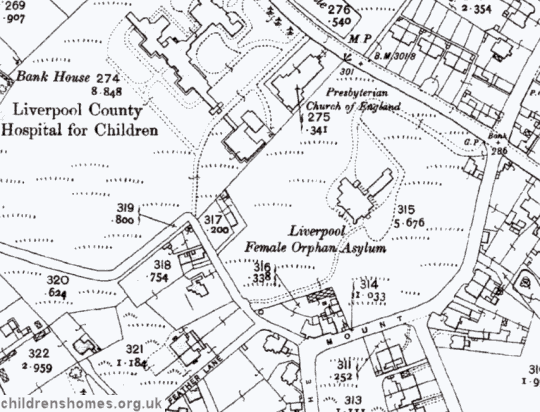Female Orphan Asylum, Liverpool, Lancashire
The Female Orphan Asylum was founded in 1840, at the instigation of Mrs James Aikin, the wife of a prominent Liverpool merchant and magistrate. Its object was to provide a home for orphan girls who had lost both parents.
Initially, the Asylum operated in a rented house on Upper Stanhope Street, with 40 girls in residence by 1842. Following a successful fund-raising effort, premises were erected for the Asylum on Myrtle Street, Liverpool. The building, which could house up to 160 girls, was officially opened on 2nd November, 1843.
Admission to the Asylum was limited to those born within seven miles of the Liverpool Exchange, and aged 7 to 11 years at their date of entry. No girls were admitted from workhouses. Applicants were required to provide certificates of their birth, baptism, and of the marriage and death of their parents.
In 1854, a Boys' Orphan Asylum was opened on a site close by on Myrtle Street, followed by an Infant Orphan Asylum on Melville Place in 1860. The Church of the Holy Innocents, funded by local businessman and philanthropist, Harmood Banner, was erected between the girls' and boys' asylums and consecrated in 1854.
The three Asylums are shown on the 1891 map below.

Female Orphan Asylum site, Liverpool, c.1891.

Female Orphan Asylum, Myrtle Street, Liverpool, 1840s. © Peter Higginbotham

Female Orphan Asylum, Myrtle Street, Liverpool, easrly 1900s.
Inmates at the girls' Asylum generally entered domestic service on leaving the institution.
In 1891, a country home known as the Towers, on Telegraph Road, Heswall, was purchased for holiday and convalescent use by the girls from the Female Asylum.

Female Orphan Asylum site, Heswall, c.1891.
In 1913, all three Asylums were placed under a single management and became the Liverpool Orphan Asylum, renamed the Liverpool Orphanage in 1925. At around this date, consideration began to be given to relocating the Orphanage away from the city centre. A fund-raising campaign was launched and in 1930 a Great Fair was held in aid of the appeal. The site for a new building was located on Woolton Road, in the Childwall area of Liverpool, and the new Liverpool Orphanage premises were opened in the summer of 1934.
Neither the Myrtle Street nor the Heswall buildings now survive.
Records
Note: many repositories impose a closure period of up to 100 years for records identifying individuals. Before travelling a long distance, always check that the records you want to consult will be available.
- Liverpool Record Office and Local History Service, Central Library, William Brown Street, Liverpool L3 8EW. Holdings include: Annual reports (1844-1913, some missing); Admission registers (1840-1925); Admission papers and certificates (1840-1924); Discharge registers (1840-1904); Case files; Visitors books (1890-1908); Accounts (from 1858); Minutes (from 1861); Correspondence (from 1856); Female Asylum Journal (1903-16).
Census
Bibliography
- Higginbotham, Peter Children's Homes: A History of Institutional Care for Britain s Young (2017, Pen & Sword)
Links
- None identified at present.
Except where indicated, this page () © Peter Higginbotham. Contents may not be reproduced without permission.


